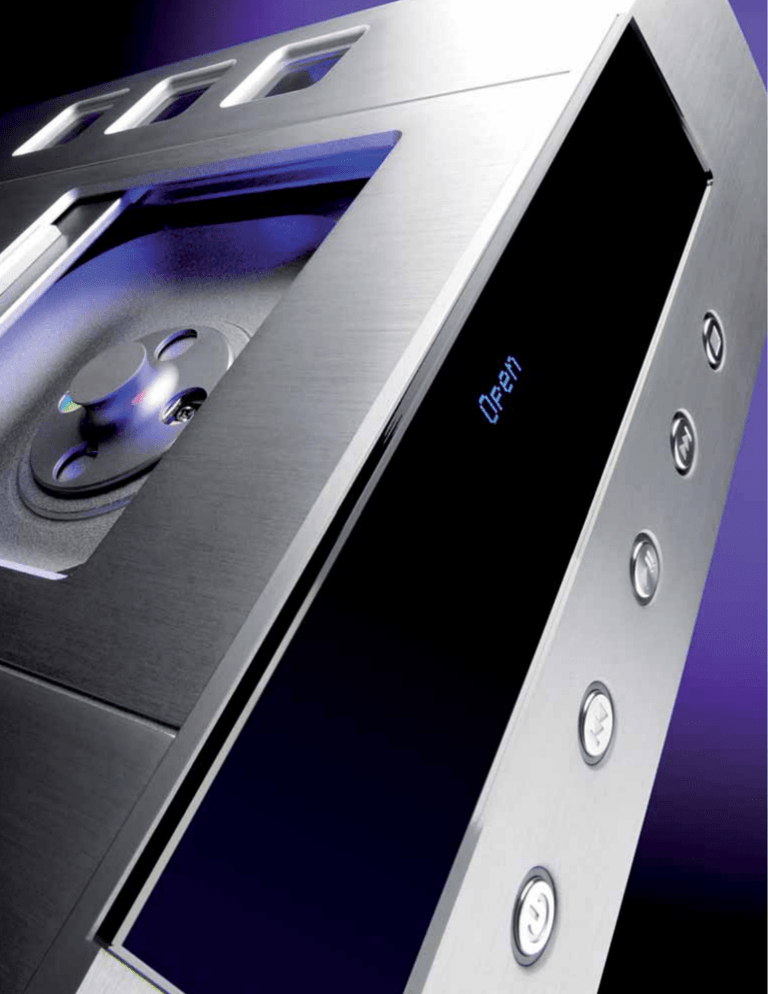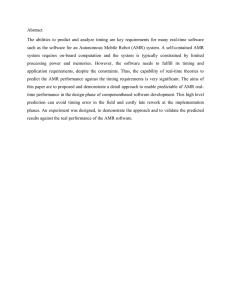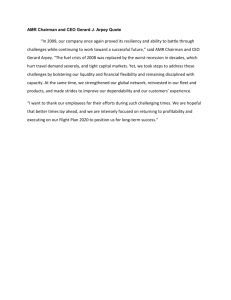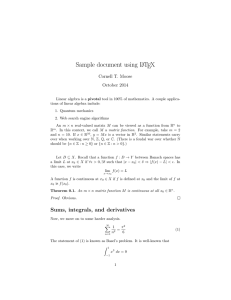Read more - Abbingdon Music Research
advertisement

EQUIPMENT REVIEW Abbingdon Music Research CD-77 CD Player by Roy Gregory Press releases which announce some new company that’s going to set new standards in CD reproduction/ amplification/speaker design are not exactly news. In a market where hyperbole is all too often a substitute for considered commentary, terms like “best”, “best in show”, “best on the planet”, even “best in the universe” cease to have much relevance, with everybody claiming to be “best” at something. The result is to discard such claims with perhaps a shade too much jaded cynicism and await events. Often, the product never emerges (at least not in any stable form) and the company simply disappears. There are however, always exceptions to every rule… When Abbingdon Music Research announced a new range of “Reference Class” products we greeted the news with the usually mix of interest and scepticism, the establishment of a watching brief. And watch we did, as months passed and products appeared in dealers and at shows with remarkable consistency demonstrating if nothing else, that here at least was a going concern; and one whose products demanded to be taken just as seriously as AMR take themselves, at least if the universally accepted “vertical displacement assessment of audio quality” is to be believed. Just try picking up the AMR CD-77 and you’ll see what I mean. At 28kg this player weighs more than many serious power amps, despite being more compact than most of them. Not that you’d exactly describe the CD-77 as small. But once you start to examine this player in detail the one thing that becomes abundantly clear is just how assiduously the designers have ticked every single audiophile box. AMR’s CD player is presented in a substantial singlebox chassis that it shares with the company’s 180-Watt hybrid integrated amp. The foursquare dimensions and tall front-panel are softened by the gentle backward curve of the fascia with its massive display panel. Thankfully, the display itself is rather more modest in size, although large enough to read from a decent distance. Five beautifully executed touch-sensitive buttons cover the basic commands with everything else you could reasonably require included Reproduced from Hi-Fi+ Issue 56 www.hifiplus.com on the solidly executed touch screen remote (which illuminates in matching blue to allow operation in the dark). But the real story becomes apparent once your gaze takes in the top-panel. In front of the enormous, machined logo, a sliding lid covers the top-loading transport. Open it and you see the curved walls of the transport well, compliantly mounted to the massive chassis. The transport itself is a carefully selected mix of Philips and Sony parts, driven by a specially selected motor and assembled by AMR into the underside of their own CNC machined housing, complete with its own integral spirit level. The disc is anchored in place using a large footprint magnetic clamp, and the entire transport section is flooded with blue light from a ring of LEDs set in the underside of the chassis top-plate, light that leaks eerily from the other significant visual feature, the two rows of three windows that flank the transport lid. Actually they’re not really windows, slots on either side providing ventilation for the valves employed in the dual-mono analogue output stages (I said they’d ticked all the boxes). The rear panel carries single-ended and (transformer coupled) impedance balanced analogue outputs, but no digital output. This might seem like an oversight at first, but actually is EQUIPMENT REVIEW simply another manifestation of AMR’s confidence in the abilities of their product. The heart of the CD-77 is its sophisticated DAC implementation, so why would you want to bypass it? Instead, there’s a mini-USB digital input, allowing you to take advantage of the onboard DAC with external sources. Why all the fuss about the converter? Well, that’s where the AMR really does break new ground, not so much in terms of hardware, but in the way in which it has been implemented. Converter is the established Philips TDA1541A, allowing the use of external digital and analogue filtering, in this case the latest complex programmable devices from TI. This digital combination allows the user to select from six different filter arrangements via a single button on the remote control. Crucially, these options include two that eliminate the digital filter altogether (one with analogue filtering, the other without) along with choices of two or four-times oversampling or up-sampling to 96 or 192kHz – which pretty much covers all the bases, digitally speaking. AMR take great care to optimise the operating parameters of both devices, as well as providing a single, temperature optimised master clock that is different, but crucially in the company’s opinion, all the other clocks throughout the entire system are synchronised to, in order to reduce jitter. Power supply is extensive as you might expect, and heavily regulated too, with a separate power line for each functional block within the circuit. However, what makes it special is that each feed is regulated according to purpose, delivering a supply optimised to the function of the devices in question (low-noise, low-impedance etc). The main supply is itself extremely an sophisticated linear design, providing both filtering of noise and waveform correction, as well as auto-adaptation to any voltage standard connected to it. Internally, component quality is excellent with each individual item carefully selected, heavily plated circuit boards and textbook implementations rather than cut corners. Each mono analogue output stage is a zero-feedback, pure tube design, built around a 6CA4 rectifier feeding an ECC81 gain stage and 5687 output buffer, delivering good linearity and low output impedance. All tubes are NOS. Built into the outer portions of the chassis, the internal sections are carefully divided by solid copper plates, while purposely mixed materials and dimensions are used to further minimize structural resonance. Aerospace isolators are incorporated into the feet to reduce the impact of external vibration and AMR supply single-ended interconnects, a superior mains lead, a USB lead and a burn-in disc, all to help ensure that you achieve optimum performance. They even go Reproduced from Hi-Fi+ Issue 56 www.hifiplus.com the extra mile to make sure it arrives in one piece, packing the whole kit and caboodle in a foam-lined flightcase. But the best news of all is that this single-handed assault on the high-end weighs in at what, given its constructional and component quality, fit, finish and presentation, seems like a bargain price. Line this up alongside the vast majority of £10K audiophile players and it makes them look cheap, in some cases downright shoddy. Yet the AMR costs “only” £4400. Not exactly pocket-money I grant you, but definitely material value in today’s market place. So, like I said, it’s ticked pretty much every audiophile box, it looks the part and the price is definitely right, but does the sonic whole add up to more than the sum of the parts? In a word – absolutely. This impressive players steps straight into the slot next to the Muse Erato II as the new benchmark for serious high-end performance. Of course, in doing so it also offers a stark contrast to that machine, its dedicated CD-only stance and heavyweight build as resolutely traditional as the American player’s modular, multi-format approach is current. That fact alone will tend to leave you gravitating in one direction or the other, but the sonic contrast is just as stark, the Muse’s unforced evenness and easy separation of instruments quite distinct from the fuller and more dynamically forceful style of the CD-77. Which brings us to the nub of the question; which CD-77? For in truth this is six players in one. However, I can make things somewhat simpler than that. AMR are firm advocates of their digital filterless outputs, dubbed Digital Master I and II, and I concur. In comparison I find the over and EQUIPMENT REVIEW up-sampled outputs (especially the 192kHz filter) more detailed, more focussed and transparent – but also thinner and lacking in the sense of surefooted tempo and coherent musical sweep that comes from the un-filtered outputs. There’s a presence, body and engaging momentum to the latter that won me over immediately. Of the two settings, DM I sounds sweet but slightly heavy and shut-in. The analogue filtering employed on DM II adds air, light and energy to the top-end, balancing the weight and substance at low-frequencies making the most of the player’s expressive coherence and sense of musical involvement. But there’s a coda here. Experience shows me that I value a well-executed filterless DAC just as surely as I tend to shy away from up-sampling, but not everybody agrees. I spent considerable time listening with both the 192kHz and the 4x over-sampling filters, because I really wanted to be sure that my preference for the DM II output was a stable, long-term judgement. Along the way I learnt that despite the subtle synthetic sheen that I detect with up-sampling, along with the temporal disturbance and lack of natural flow in the music I also expect, these artefacts were significantly reduced with the AMR and certainly far less intrusive than I’ve ever experienced before. The bottom line? Don’t assume that just because you are a listener who values the transparency and focus that comes with digital interpolation that the CD-77 isn’t for you. Unlike many machines the different yet exactingly engineered choices on offer here are both genuine and legitimate. I prefer DM II: those troubled by brighter systems might find DM I the perfect panacea while the listener looking for the sort of precision that delivers detail without dismantling the music might well reach straight for the 192kHz output. Each choice is individual and equally valid. The important thing is that the AMR allows you to make that choice rather than simply living with the designer’s preference. Having said that, let’s get back to my preference and the considerable enjoyment I’ve extracted from the CD77 in its filterless mode. Comparing the ultra-purist, zero-filtering option of Digital Master I to the analogue only filtered Digital Master II is interesting indeed. Both settings (switchable, along with the other filter options via a single button on the remote) deliver substance, weight and a sense of natural flow to the music. The first thing that strikes you is the extra air and space, the lighter balance of DM II, but the more you listen the more musically fundamental the contrast becomes, the analogue filter offering a lighter, quicker and more agile reproduction, with a natural sense of position and separation between instruments, a greater sense of pace and momentum in the music. In comparison DM I sounds dull and actually rhythmically restrained, slowing the tempo in the music. Julia Fischer’s recent Tchaikovsky Violin Concerto (on Pentagram, and just as good as RSF claims) is the perfect example. Switching from DM I to DM II infuses the music with a lightness of touch and energy that underlines Kreizberg’s control of tempo, the restraint he’s imposing and the tension he creates before the first solo entry, a palpable anticipation Reproduced from Hi-Fi+ Issue 56 www.hifiplus.com that’s carried forward on a burgeoning orchestral swell that totally escapes DM I. Fischer’s opening phrases are equally telling: slow and measured on DM I, switch settings and they gain a sense of fluidity and grace, a slowly increasing tempo emerges that adds drama to their obvious lyrical qualities. It’s about letting the music speak and DM II simply allows the musicians a greater vocabulary, a greater range of expression and as a result, far more dramatic performances. Overall, the sound of this player is engagingly lively, pacey and substantial. I suppose comparisons with Audio Research’s top-loading, valve output CD7 are inevitable, especially given its “ever-present” status around here. Indeed, in many respects the players are more alike than different – no bad thing for the AMR. Used directly on a finite elemente rack the CD-77 sounds at once solid but somewhat homogenous, images and instruments bleeding into each other to create a single, compact block of sound. There’s also a subtle but persistent glossy hollowness to its midband tonality. Compared to the ARC, the British built machine lacks the expansive soundstage and sheer range of texture and colour conjured by its American counterpart, but offers better bass definition and transparency whilst sharing the sense of easy, unimpeded musical momentum. However, we can improve things. Despite AMR’s protestations to the contrary, I find that the CD-77 (just like the ARC) does indeed benefit from attention to its support. Inserting three Stillpoints cones to bypass the soft feet opened out the soundstage, improved separation and the focus and solidity of individual instruments and voices and banished most of that hollowness from the tonality. Likewise, leaving the player running for extended periods improves its tonal range, overall fluidity and EQUIPMENT REVIEW low-level detail. In this form, the urgency that underpins the Cure’s Seventeen Seconds, the step-change in tempo between ‘A Reflection’ and ‘Play For Today’ is beautifully portrayed, the first deliberate but with a coiled anticipation, the second explosively forceful, forging ahead in a helter-skelter rush. Likewise, the bi-axial juxtaposition that opens ‘M’ works to perfection, the keyboard whoosh that travels left to right having a studied inevitability, an even progress and eventual impact that most players fail to deliver where vinyl succeeds so handsomely. The solid snare and bass drum doublets that characterize the album have real snap and impact to count against the solid thud and weight lower down, driving the track forward. Indeed, this ability to lean into the music is one of the AMR’s real strengths. With the added temporal and spatial definition delivered by careful siting and long-term use, the AMR’s homogeneity becomes a virtue, offering a combination of evenness and substance top to bottom that is rare indeed. In this important respect it surpasses the Audio Research, whose nicely timed bottom end is nevertheless exposed for its roundness and lack of shape. Nor is this a musical quality that’s exclusively applicable to rock and pop music. Classical music and in particular the wider romantic repertoire really responds to the AMR’s presentation, with orchestral contrasts of dramatic scale and compass. The sense of body and presence platters voices, be they simple girl and guitar or the far more extreme demands of grand opera. Anna Netrebko’s Valentina in the Rizzi/Vienna La Traviata has a range and power that justifies the hype, the CD-77 managing to convey her wonderful voice in all its glory (and Villazon isn’t too bad either!). It’s this ability to rise to meet the qualities in a performance, to match the scale and drama that makes the AMR so special, elevating it into exclusive company indeed. Whether it’s a stretched out, bluesy jazz line, slashing guitar heroics or a beautifully turned orchestral phrase, this player allows the music to deliver, allowing you to relax and enjoy it. There will be those who demand greater precision, separation and transparency, those who choose a Krell Evo 505 over the Audio Research CD7. Whilst the sound I’ve enjoyed from the AMR is firmly on the Audio Research side of that see-saw, don’t discard the player’s up-sampling options if you find yourself leaning the other way. Indeed, with some modern and particularly murky pro-tooled recordings, the added incisiveness of the interpolated signal actually helped deliver a welcome degree of insight amidst the fog. It also helped to underline just how versatile and accomplished this debut player is. When I suggested earlier that it helps establish a new performance benchmark I wasn’t joking. That doesn’t make it or the Muse Erato II the best player out there. But it makes them the machines against which you should compare the more expensive offerings. Believe me, more than a few are going to fail to justify their extra cost, while the options inherent in the CD-77 will broaden its appeal considerably. AMR might not have set out to make a machine that offers all things to all men, but they’ve got astonishingly close to doing so… TECHNICAL SPECIFICATIONS Type: Single-box CD player Input: 1x USB Transport: Top-loading proprietary DAC: Philips TDA1541A Filters: User selectable filterless, up and over-sampling Output Stage: Dual-mono valve Tube Complement (NOS): 2x ECC81 2x 5687 2x 6CA4 Outputs: 1pr single-ended phono 1pr balanced XLR Output Level: 2V Output Impedance: <150 Ohms Dimensions (WxHxD): 460 x 160 x 470mm Finishes: Champagne or titanium Weight: 28kg Guarantee: 5 years Number of UK Dealers: 5 Price: £4400 UK Distributor: Real Hi-Fi Tel. 0870 909 6777 E-mail. info@realhi-fi.com Manufacturer: Abbingdon Music Research Net. www.amr-audio.co.uk Reproduced from Hi-Fi+ Issue 56 www.hifiplus.com




